Deep Blue Camera System
DEEP BLUE - remote real-time monitoring in the marine environment
A product of the NRF(THRIP), DTI-Industry Partnership Program
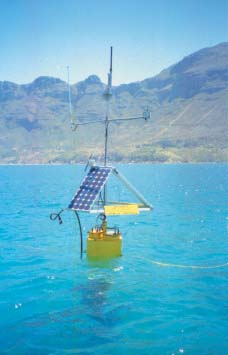
THRIP Project: Climate change and squid catch prediction
Project leader: M. J. Roberts
Fishery Problem: Sub optimal performance and socio-economic hardship
The South African squid fishery is based in the Eastern Cape and made up of some 150 SMMEs, directly providing jobs for 2 500 fishermen. Fishermen go to sea for periods of 21 days and are paid accordingly for their catch. Including families, this means about 25 000 people are dependent on the performance of this fishery for a livelihood. The entire catch is exported mainly to Europe and Japan, which brings much needed foreign revenue into South Africa and particularly to the impoverished Eastern Cape. The high value of the product ranks this industry as the 4th most important of the South Africa fisheries.
Fishermen go to sea for periods of 21 days and are paid accordingly for their catch. Including families, this means about 25 000 people are dependent on the performance of this fishery for a livelihood. The entire catch is exported mainly to Europe and Japan, which brings much needed foreign revenue into South Africa and particularly to the impoverished Eastern Cape. The high value of the product ranks this industry as the 4th most important of the South Africa fisheries.
Squid catches, however, fluctuate greatly and are erratic. Such uncertainty hinders optimal performance of this fishery. Moreover, during times of poor catches, the income of fishermen is severely reduced. In some instances, boat owners (including new black entrants) have defaulted on vessel repayments and jobs were lost. Under these circumstances, socio-economic hardship impacts severely on coastal communities.
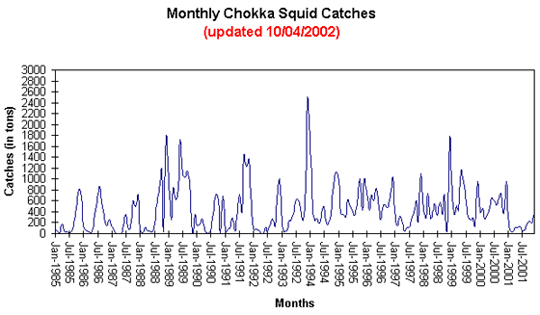
Squid catch predictions
Timely forecasts of squid catches would enable the squid fishery to prepare for difficult times. Prudent decisions, based on forecast information, could reduce the socio-economic hardship, as well as optimise international market strategies. Until recently no such capability existed for squid fisheries world-wide. The environment is thought to play a major role in catch variability.
A particularly difficult scientific problem encountered: Quantifying squid spawning behaviour in situ
In striving to develop a squid catch forecast capability, a particularly difficult but pivotal problem arose - how does one quantify squid spawning behaviour, and link this to measured changes in the environment.
Squid spawning behaviour is intricate. Mature squid migrate to the shallow waters of the Eastern Cape to spawn and lay their eggs on the seabed. Here the males and females mix forming large aggregations comprising thousands of animals. The fishing fleet target these aggregations and catch the squid using hand-held jigs. Good catches rely on large and frequent aggregations.
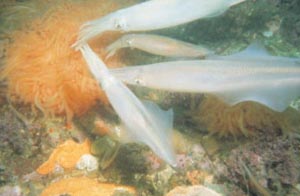
The spawning process, however involves a complex set of interactions between the biology, behaviour of squid, and environment. During the mating process, jostling between competing males takes place, followed by copulation with the prised female. Research shows that as many as 4 males can be used to fertilize one egg stand. Female squid are capable of laying as many as 80 egg strands within a day or two. During the spawning process, a complex set of visual body postures and chromatophoric patterns are used for intra-specific communication. Correspondingly, squid have very well developed eyes. Three environmental factors are thought to impact on the spawning process, these can prevent or terminate spawning: water temperature, waves and bottom turbidity. The latter two parameters involve exceptionally low underwater visibility near the seabed. It is thought that benthic turbidity prevents intra-specific communication (i.e. squid talking to squid), and hence disturbs the spawning process. No spawning means no aggregations and hence low catches. The impact of turbidity on chromatophoric communication is a hypothesis and needs to be tested and quantified. The challenge is, how can this be accomplished?
Deep Blue :The Potential Solution to the Problem
"Deep blue" was conceptualised as a solution to the quantification problem. Deep blue, as it is commonly referred to, is a self contained, steel, ocean buoy system that transmits 4 underwater video images, animal (hydro-acoustic) positions, and seabed environmental data (e.g. temperature, wave height and turbidity) to a shore based receiving station (or nearby vessel) for real-time monitoring.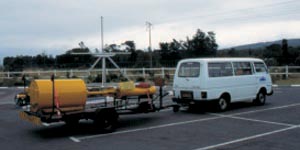 It is designed to operate in depths up to 100 m and transmit data over a distance of 10 km. This enables quantitative monitoring to take place indefinitely without interference from the observer i.e. divers or submersible vehicles. The formal name for Deep blue is an Underwater Video-Environment-Acoustic Telemetry System (UVEATS).
It is designed to operate in depths up to 100 m and transmit data over a distance of 10 km. This enables quantitative monitoring to take place indefinitely without interference from the observer i.e. divers or submersible vehicles. The formal name for Deep blue is an Underwater Video-Environment-Acoustic Telemetry System (UVEATS).
Deep blue is designed to withstand severe weather conditions - a time when observations are most important. The buoy is self-contained using electrical power supplied from 6 solar charged 12 V batteries located well beneath the sea surface to enhance buoy stability. Vertical and horizontal stability (i.e. minimal movement) are important characteristics of the design. Despite it's size (7 m) and mass (500 kg), it is easily transported on road using a trailer.
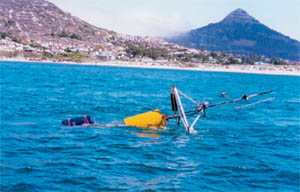
On the water it is towed in a horizontal position to the site of interest using an airbag and inflatable boat. It is then tilted into a vertical position by releasing the air bag. Two constant tension mooring lines (buoyancy-gravity springs) are set to hold the buoy in position. SCUBA divers deploy the 4 underwater video cameras on the seabed and orientate each so that spawning squid are in view. Environmental sensors are attached to one of the camera frames.
In this project, male and female squid are caught using hand-held jigs. Micro hydro-acoustic electronic transmitters (50 mm x 10 mm) are quickly inserted into the mantle (body) and the animals released. Each transmitter emits an identifiable acoustic signal, which is received by a suspended hydrophone hanging below the buoy. The listening range of the electronic tags in water is about 200m.
The quantification of the squid spawning behaviour is accomplished by counting the number of times per minute a female squid goes to the seabed to lay an eggs. This rate is proportional to the size and intensity of the spawning aggregation.
(These and more details can be found in the publication: M. J. Roberts - The influence of the environment of chokka squid (loligo vulgaris reynaudii) spawning aggregations: steps towards a quantified model. South African Journal of Marine Science, vol 20 pp. 267-284)
Uniqueness
The overall concept and design of Deep blue is unique and was undertaken by Mike Roberts working for the Sea Fisheries Research Institute in Cape Town (now Marine & Coastal Management) between 1995-1996. Several existing technologies were incorporated for the electronic modules i.e. solar energy, microwave video and data telemetry and the hydro-acoustic system. The latter was customised by Vemco, a Canadian company specializing in underwater hydro-acoustics.
Enabling factors for Deep Blue (and the project)
Once it has been established that this method of using underwater video cameras and micro-acoustic electronics was a feasible means of quantifying the relationship between the environment and spawning - substantial funds were required to develop the concept. A number of institutions rallied their support for this project: the Sea Fisheries Research Institute (now MCM)), the South African Squid Management and Industrial Association (SASMIA), DTI through the THRIP program of the National Research Foundation, and Bay World (Port Elizabeth Museum). Without this support Deep Blue would only have remained at the concept phase.
Opportunities
After several modifications to the video telemetry link, a final version of Deep Blue appeared in 2002. Today (2002) Deep Blue would cost between R 500 000 - 1 000 000 to manufacture, depending on the selection of the environmental sensors.
Deep blue is a research tool at present, designed to monitor and quantify animal behaviour in the sea and to relate this to changes in the environment. However, a number of commercial uses exist, particularly for the video and environmental components. For example, Deep Blue can be used in coastal engineering to visually monitor sediment scouring around submerged structures and simultaneously provide (real-time) environmental measurements driving the process. It also has internet potential - several inquires have been made with respect to using Deep Blue for webcam viewing in the sea off the coast of Kwa-Zulu Natal to observe tiger sharks and coelacanths.
Enquiries
- Mike Roberts, Marine and Coastal Management, Cape Town
- Tel: +027 021-402 3318 Cell: 082-4964190
- e-mail: Mike Roberts
- Rick Harding, Marine and Coastal Management, Cape Town
- Tel: +027 021-402 3311 Cell: 0721941027
- e-mail: Rick Harding


